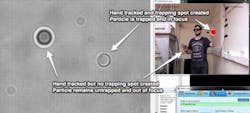Dundee, Scotland--According to an article whose abstract is posted on the Cornell University Library website at http://arxiv.org/abs/1211.0220, researchers at the University of Dundee have developed HoloHands technology that uses Kinect-based gesture recognition to control optical tweezers—essentially allowing anyone to pick up and move micrometer-scale particles using their hands and arms.
Microsoft's Kinect is a motion-sensing device that allows people to control Xbox video games using body movements alone. It consists of a webcam-like camera for creating an image of players, an infrared laser for measuring their distance, and a specialized microchip that interprets the data to track people and objects in three dimensions. After Microsoft released software developer kits allowing anybody to develop applications for the Kinect on both the Xbox and on Windows, David McGloin and colleagues at the University of Dundee in Scotland were able to apply Kinect technology to their area of expertise: optical tweezers, in which highly focused laser beams can trap, move, and even rotate small particles such as cells.
Using Windows 7 and a Kinect, a whole body of small particles can be controlled. The interface allows users to "pick up" and "push" particles they see on a computer screen using hand, arm, and body movements alone. The system shows users the field of view in which the tweezers operate. A wave of the hand creates a trapping region, which holds particles. They can then be picked up and moved with further arm movements. The system was tested by moving around silicon microspheres just a few micrometers across, demonstrating the effectiveness of the Kinect-enabled technology called HoloHands.
But McGloin and his team report that manipulating particles over long periods of time is a tiring business. The Kinect system also lacks a way to perform quantitative measurements. "This makes it challenging to use for precision work," they say. However, they point out that HoloHands is a useful teaching aid and should have great potential in showing a new generation of students the potential of optical tweezers. It's not beyond the realms of possibility to imagine that simple laser tweezer games might be possible with such a system—pong played with silicon microspheres, for example.
With a little more development it could give students an intuitive understanding of physics on this scale and how it differs from the macroworld. "Micropong" played with silicon microspheres suspended in water would have rather different dynamics to the same game played with a tennis ball, for example. It may also be possible to build stuff by hand using such a device. It's not hard to imagine a kind of Lego-like set up where students make microscale devices and machines using HoloHands.
SOURCE: MIT Technology Review; www.technologyreview.com/view/506856/physicists-build-laser-tweezers-controlled-with-kinect/

